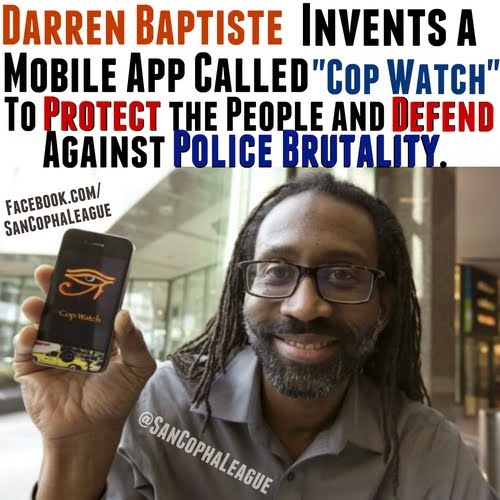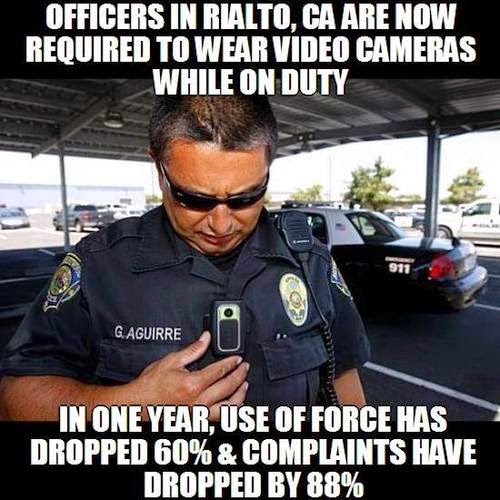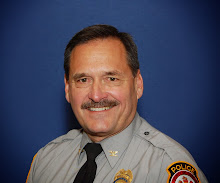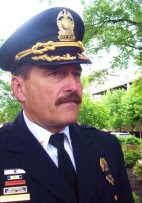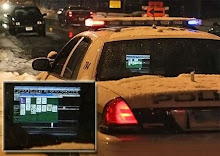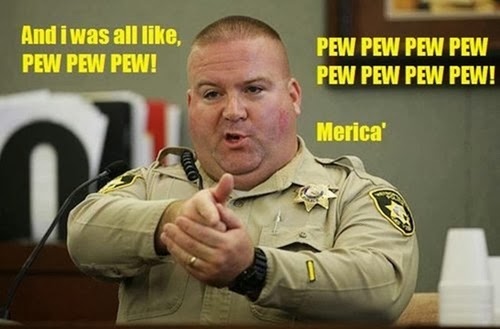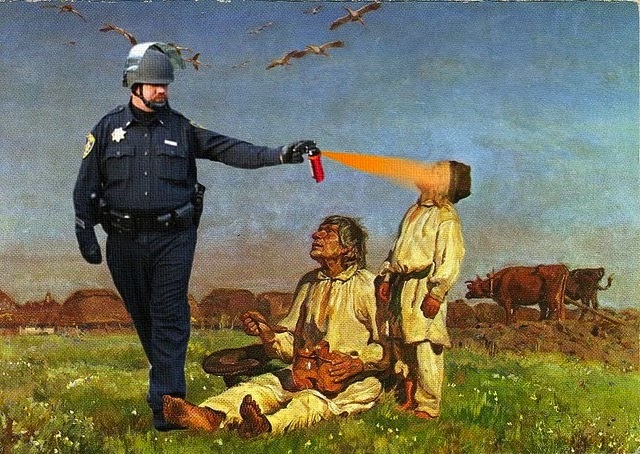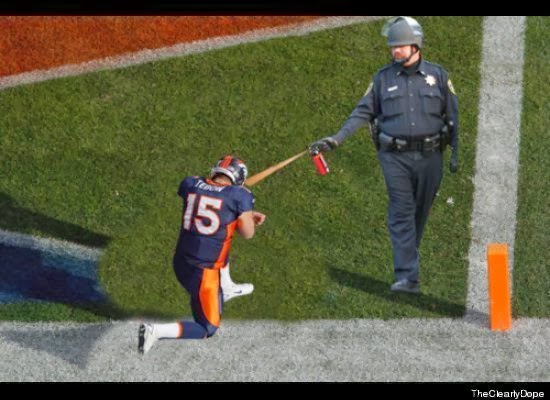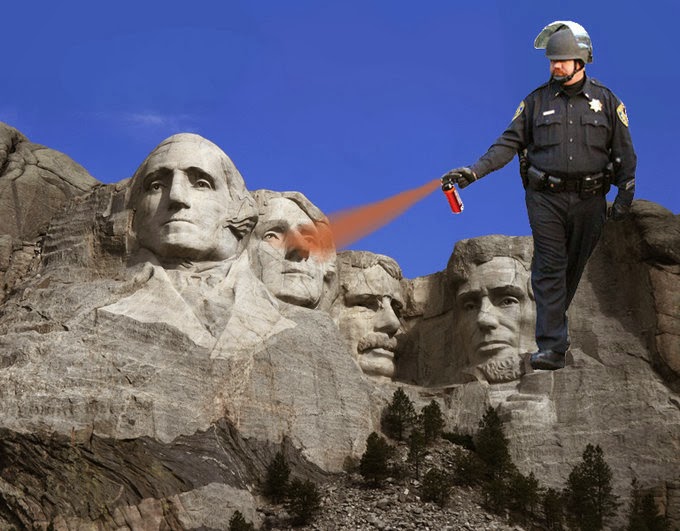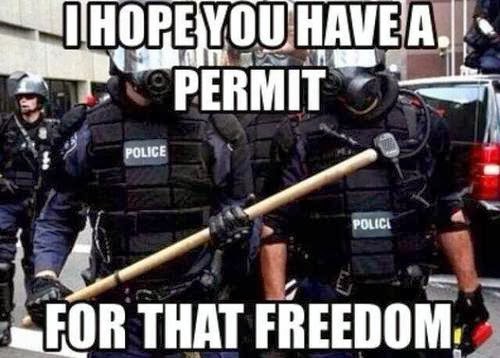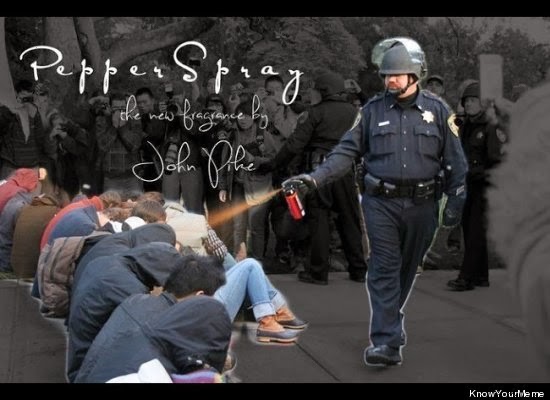Police reform may be progressing, but not police diversity
• Dec
27, 2016
Dear Editor,
If you’ve not been following the
Fairfax County Supervisors’ actions to implement the recommendations from the
Ad Hoc Commission on Police Practices for the last 14 months, let’s briefly
catch you up.
The Commission, consisting of 36
members including 10 active or retired police, submitted its final report to
the Fairfax County Supervisors in October 2015. The report contained 202
unanimous, transformational recommendations to restore accountability and
public trust in the Fairfax County Police Department.
To date, the FCPD and other
county offices have implemented, or “implemented with modifications” over sixty
per cent of the recommendations. Another 25 per cent were approved in
principle, with details, some critical, still to be finalized. Ten per cent
more complicated or contentious ones are still under review. Four percent were
not implemented.
In sum, this is better progress
than many of us expected. Supervisors deserve credit for pushing ahead in the
face of often strong resistance from three unions.
Recommendations “implemented with
modifications” include some major changes from Commission proposals. For
example, the “independent police auditor” lost some independence and had its
role in criminal investigations restricted. Proposed reforms calling for more
transparency and accountability to the public face stiffest opposition and
delay. Examples include proposals to require prompt disclosure of names of
officers killing citizens and, to adopt body cameras for all officers. The
former was finally approved but with lots of wiggle room, and the latter is
still awaiting even a limited pilot test, perhaps in 2017.
A recommendation to encourage the
use of less lethal force by requiring all officers to carry Tasers (in addition
to guns) is still being debated. While overall percentages look good, a closer
look reveals critical, not cosmetic, exceptions.
There is one area where I believe
the Commission failed to deliver recommendations likely to lead to change. The
Commission was charged with reviewing the composition of the force and making
recommendations to improve its diversity. The force is a bastion of white males
in a diverse county. Women and minorities are grossly underrepresented, a
situation which has not improved in the last several years.
Whites make up only 63 % of the
county population, but 83 % of the force (only 1 in 8 of are women); blacks
make up 9 % of the population, but only about 7 % of the force; Latinos are 16 %
of the population, but are just under 5 % of the force; and Asian Americans
make up over 10% of the population, but only 4 % of the force.
The Commission’s subcommittee on
Recruitment and Diversity offered only two recommendations to improve
diversity:
1) establish a diversity goal for
each (of 8) commanders; and,
2) educate and train recruiting
and selecting officers about implicit bias.
That’s it, nothing more. The
supervisors adopted both verbatim, thus apparently deferring action toward a
force composition reflecting the community they serve. Perhaps the board’s
number one New Year’s resolution should be to formulate and implement some serious
affirmative action in the FCPD.
To see the Commission’s
recommendations and implementation progress to date, go to
www.fairfaxcountypolicecommission and scroll down to “progress report”.
Happy New Year to all!
John Lovaas
Commentary: Fairfax Police Reform Is Well Underway
By Phillip Niedzielski-Eichner
Monday, December 19, 2016
#I endorse the Connection
Newspaper’s recent editorial on the progress Fairfax County has made
implementing the recommendations of the Ad Hoc Police Practices Review
Commission, on which I had the honor of serving as chairman of the Use of Force
Subcommittee. I have had the opportunity to interact with many members of the
Fairfax Police Department, ranging from commanders to precinct-level
supervisors and officers, all of whom I hold in high regard. We have a fine
police department that we are fortunate to have protecting us day-in and
day-out.
#While the August 2013 shooting
death of John Geer was the catalyst for the commission’s formation, our charge
was to assess the Department’s performance against national best practices. As
we executed against this charge, we identified both areas for improvement and
mechanisms we believed would strengthen the public’s trust and confidence in
the department.
#Forming a commission is a
time-honored tool by public officials to delay action — or avoid it altogether
— since there are always significant barriers to achieving change to
deep-rooted organizational practices, traditions and culture. I commend both
the Fairfax Board of Supervisors and the Police Department, particularly its
chief and command leadership, with ensuring that the Police Commission’s work
is not sitting on the shelf gathering dust.
#With my seven-month commission
experience and a year’s worth of persistent focus on implementation alongside a
dedicated subset of fellow commissioners, I can state without reservation that
both the letter and spirit of the commission’s recommendations have been
embraced by Fairfax County.
#Fairfax County is well on the
way toward approving and implementing the preponderance of the commission’s
recommendations. Of note in this regard are the following:
The
two-pronged approach to independent Police Department oversight advocated by
the commission and recently approved by the Board of Supervisors is significant
in light of historical resistance to civilian review of police actions.
The
changes directed by the supervisors and Chief Roessler with regard to the
Police Department’s openness and transparency are substantial and have already
helped regain the public trust lost, in part, because of the dismal handling of
the Geer case.
The
county’s investment in Diversion First, which provides treatment rather than
jail for nonviolent people with mental illness, and broad-based police officer
training in crisis intervention techniques, are already paying dividends. Those
with mental illness are being treated with greater sensitivity to their
affliction, easing the potential for unnecessary suffering, while also reducing
the potential for officer injuries and the need for the use of force.
Ultimately, this will also help insure a more effective use of tax dollars.
#As important and forward leaning
as these steps are, I believe the recrafting and rewriting of the Police
Department’s Use of Force policy, also known as General Order 540, warrants
particular note. The new Use of Force policy encompasses the commission
recommendations, which also incorporated use-of-force recommendations made by
the independent Police Executive Research Forum. It gives emphasis to the
sanctity of human life, dignity and liberty of all persons as its overarching
value or driving theme; and it calls for de-escalation as the strategy of first
resort when confronted with a threat rather than the use of deadly force.
#Every member of the Fairfax
Police Department, from command leadership to police officer will receive
training under General Order 540 by the end of January, 2017. Police officer
performance will be assessed against the standards set in this policy, while
recruitment and vetting of police officer candidates will focus on the
abilities and temperament that comport with the values captured therein.
#While the preponderance of our
recommendations have been approved and are being implemented, there are
exceptions. For example, we called for all officers being outfitted with body
worn cameras, to complement the dashboard cameras now mounted in each patrol
vehicle. We believe such cameras will benefit both the public and the police
officer. The supervisors delayed consideration of this recommendation for
important matters of budget and privacy concerns, which I believe will
ultimately be overcome.
#I encourage everyone who is
interested to review the Police Commission recommendations progress report at
http://www.fairfaxcounty.gov/policecommission/progressreport.htm. In summary,
you will find that 178 of the 202 recommendations (88 percent) have been
approved and are either in process of being implemented or have already been
implemented; 15 (7.4 percent) are still under review; and 9 (4.5 percent) have
been rejected.
#The evidence so far is that the
deep-rooted change of the nature and spirit advocated by the commission is more
achievable now than even the most optimistic expected. This noted, I caution
that the transformative progress I have observed can only be sustained over
time with the continued county and Police Department leadership commitment, the
active involvement of the police rank and file officers and most critically
continued community participation, monitoring and oversight.
#Phillip Niedzielski-Eichner
served as chairman of the Use of Force Subcommittee of the Ad Hoc Police
Practices Review Commission, and continues service on the Implementation
Committee.
Fairfax County: Filling Oversight Positions
Supervisors outline procedures
for bringing on police auditor and civilian review panel.
Tuesday, Dec. 6, the Board of
Supervisors voted 9-1 in favor of establishing a nine-member independent police
review panel comprised of citizens. Photo by Tim Peterson.
By Tim Peterson
Friday, December 16, 2016
One week after voting to
establish Fairfax County’s first Civilian Review Panel for police, Public
Safety Committee chair supervisor John Cook (R-Braddock) and Board of
Supervisors Chairman Sharon Bulova outlined steps to be taken to fill the
nine-member panel, as well as hire an independent police auditor.
Near the conclusion of the Dec.
13 Public Safety Committee meeting, Cook said a letter will be sent to
organizations around the county by the end of December inviting them to submit
nominees for the review panel. Those groups include minority organizations,
disability services, interfaith groups and others that were part of the
Election Process Improvement Commission.
Each supervisor will also be able
to nominate individuals for the panel.
Cook said all nominations should
be received by Jan. 31, 2017. For the next two weeks those applications will be
available to the supervisors, who will then review them in closed session on
Feb. 14.
On Sept. 20, the board created
another oversight entity, the office of the independent police auditor. Both
bodies were recommendations from the Ad Hoc Police Practices Review Commission.
The members of the Civilian
Review Panel will be volunteers, while the Independent Auditor and staff will
be paid Fairfax County employees.
The job posting for auditor has
closed, and received many applications, Bulova said. Six candidates have been
determined by Fairfax County human resources to fulfill the requirements of the
advertisement, supervisor Penny Gross (D-Mason) said.
Bulova said she’s appointed a
screening committee for the auditor applicants, including Auditor of the Board
Jim Shelton, Connection Newspapers publisher and Ad Hoc Commission member Mary
Kimm, Ad Hoc Commission member Adrian Steel, chair of the commission’s
Independent Oversight and Investigations subcommittee Jack Johnson, and
supervisors Gross and Cook.
Earth shattering news, another cop in Fairfax County Goes Free
Sheriff’s Deputy Involved in
INOVA Hospital Shooting
is Cleared
Authorities said it appeared
Jovany Amaya Gomez, 29, was having some sort of "mental episode." The
hospital had released him.
By Mary Ann Barton (Patch Staff)
- December 17, 2016 2:01 am ET
FAIRFAX COUNTY, VA -- A sheriff's
deputy has been cleared in a fatal shooting from Aug. 15 at INOVA Fairfax
Hospital, FCPD announced Friday afternoon. Jovany Amaya Gomez, previously
identified as Giovanny Martinez, 29, died after he was shot by the deputy. He
had approached a police officer earlier in the day because he was suicidal, and
the officer had called an ambulance for him, the Washington Post reported.
After he was released from the hospital, waiting at a bus stop, he charged at a
sheriff's deputy carrying a metal sign post. The deputy shot and killed him,
police said.
"Fairfax County
Commonwealth’s Attorney Raymond F. Morrogh has informed Colonel Edwin C.
Roessler Jr., Chief of the Fairfax County Police Department, that he finds no
basis for criminal liability on the part of the Fairfax County Deputy Sheriff
involved in the deployment of deadly force on Monday, August 15, 2016, on the
campus of INOVA Fairfax Hospital," a statement reads from the police.
The Fairfax County Sheriff’s
Office will conduct an administrative investigation in accordance with its
standard operating procedures.
Martinez died at Inova Fairfax
Medical Campus, 3300 Gallows Road in Fairfax County. Authorities said it
appeared Gomez was having some sort of "mental episode." The incident
began Monday night, shortly before 10 p.m., when Inova Fairfax Hospital
security called the Fairfax County Department of Public Safety Communications
(DPSC) to report that a suspicious man with "some sort of edged
weapon" was seen at a bus stop outside the “green” garage on the
hospital's campus, police said.
A deputy with the Fairfax County
Sheriff’s Office, who was in uniform and on assignment at the hospital,
responded to the bus stop and located the suspicious man, according to police.
Police say the man threatened the officer with some sort of object and the
officer shot him. Police did not say what part of the man's body was hit.
Three Fairfax County police
officers arrived and began to render aid to Gomez, and personnel from the
Fairfax County Fire and Rescue Department, already on scene at the hospital,
arrived and transported the man to the hospital a short distance away, police
said.
The man's condition was initially
said to be non-life-threatening, Fairfax County Police said. No deputies or officers
were injured. Police said that the deputy, who was placed on routine
administrative leave, has been with the Sheriff's Office for 18 years.
Man sues Fairfax Co. officer’s over use of stun gun
By The Associated PressDecember 22, 2016 6:33
pm
FAIRFAX, Va. (AP) — A federal
lawsuit has been filed against a Fairfax County police officer over the use of
a stun gun on a man who says he has cerebral palsy.
The lawsuit filed Thursday says
the use of a stun gun on Elton Cansler in September 2015 was “grossly
excessive” and “objectively unreasonable.”
Video taken by a bystander shows
the officer, who is white, shocking Cansler in the back while his hands are on
a police car.
Police have defended the use of
force, saying Cansler was armed with a knife and kept reaching for it.
Cansler, who is black, was
charged with assaulting a police officer and larceny. The assault charge was
later dropped.
A police spokesman referred
questions to the county attorney’s office, which didn’t immediately return a
message.
Are the police tracking you? Push to restrict license plate readers heads to Va. Supreme Court
By Tom Jackman
The police use of automatic
license plate readers, photographing hundreds of license plates per minute and
capturing the exact time and place of the photo, has become routine in law
enforcement and is credited with helping to solve all manner of crimes, find
missing persons and locate stolen autos. But the vast data those readers
generate continues to alarm civil liberties advocates, troubled by the possibility
of police tracking people’s movements, and now a legal challenge is headed to
Virginia’s Supreme Court to determine whether the police can keep the
information indefinitely — or not at all.
Different states, and individual
police departments, have varying policies on how long the police can keep the
data from their license plate readers. In Colorado, the data can be kept for
three years. In New Hampshire, state law says the readers can’t be used at all.
In Virginia, where there is no restriction, the American Civil Liberties Union
entered the swirling controversy over data retention by suing the Fairfax
County Police Department, seeking an injunction to prevent them from keeping
the license data they currently maintain for a year. Last month, a Fairfax
judge threw the case out, ruling that a license plate is not “personal
information,” in what appears to be the first court ruling nationwide on that
issue, important in states which prohibit government from keeping citizens’
personal information.
The ACLU is appealing that ruling
to the Virginia Supreme Court. If the state high court reviews the case, its
ruling would likely set a precedent in Virginia — either allowing police
departments to maintain license data indefinitely, or requiring them to purge
it almost immediately — that could launch a similar legal shift in state laws
and police departments nationwide.
The Virginia case has attracted
attention from national groups such as the Electronic Frontier Foundation and
Vigilant Solutions, one of the largest manufacturers of LPRs, and both filed
amicus briefs in the case. The Electronic Frontier Foundation said that some
readers can capture 1,800 plate numbers per minute, and that one Northern
California law enforcement agency had collected data on 3.2 million plates in
just three months. Of those 3.2 million, only 720 were linked to crime, and the
other 99.09 percent were not, the foundation said.
Vigilant argued that a license
plate “is essentially a ‘mobile billboard’ that is seen by countless others whenever
a vehicle is in public view,” and that since government mandates license plates
be publicly visible, “the additional act of recording what everyone can see
entails no invasion of privacy distinct from this universal viewing.”
When it comes to license plate
readers, “data retention is in fact the most critical issue nationwide,” said
Chad Marlow, advocacy and policy counsel for the ACLU. He said the police
argument for maintaining data can be summarized as, “Just because, just in
case. ‘Just because we’re collecting the ALPR data,'” Marlow said, “‘we might
as well keep it just in case one of you might be a criminal.’ That is mass
surveillance to a ‘T.'”
Fairfax Circuit Court Judge
Robert J. Smith ruled in November that license plate numbers are not “personal
information” and so do not require police departments to limit their use of
automatic license plate reader data. The case is being appealed to the Virginia
Supreme Court. (Jahi Chikwendiu/The Washington Post)
Twelve states have enacted laws
specific to license plate readers, according to the National Conference of
State Legislatures, with some limiting the amount of time the data may be kept
from 21 days (Maine) to 90 days (Tennessee and North Carolina) to 18 months
(Vermont). A survey by the Electronic Frontier Foundation found most California
police departments kept the license data for one to two years, though the Los
Angeles County sheriff keeps it for five. There is no reader-specific law in
Virginia.
The Virginia lawsuit centers on
another state law, “the Data Act,” which says that agencies “shall not collect
personal information except as explicitly or implicitly authorized by law.” The
Virginia State Police, concerned about whether their collection of license
plate data violated the Data Act, asked the state attorney general for an
opinion. Then-Attorney General Ken Cuccinelli (R) advised in 2013 that active
collection of information for an ongoing case was legal but passive collection
of license plates, without a need “clearly established in advance,” was
illegal. The state police began purging their databases every 24 hours.
[Despite Cuccinelli’s advice,
Northern Va. police still maintaining database of license plates]
But many police departments in
Virginia ignored the advisory opinion and kept the data, some for as long as
two years. A bipartisan measure to limit the data retention to seven days
overwhelmingly passed both houses of the state General Assembly in 2015, but
Gov. Terry McAuliffe (D) vetoed the bill at the urging of police groups, saying
it would “negatively impact public safety.” The ACLU, representing a Fairfax
County man whose license plate had been recorded twice by the automatic
readers, sued the Fairfax police days later.
License plate readers
automatically photograph up to hundreds of plates per minute, while in motion,
then convert the numbers into text and continuously compare those with a “Hot
List” of stolen auto plates and cars related to other crimes. If a connection
is made with the Hot List, a monitor in the car alerts the officer, who can act
immediately. Storing the plate numbers, and their locations, also enables
police to look back in time to try to link a car to a crime scene, or to find a
missing person.
License plate readers were used
by police in New York to help track down a man suspected of planting bombs in
Manhattan in September. Police in Arlington, Va., found a 67-year-old man who
had been missing for two days, and was near death, when his car was recorded
blocks away from his residence. A 2012 survey of police departments by the
International Association of Chiefs of Police found that departments using
license plate readers had increased their stolen auto recoveries by 68 percent.
Don DeLucca, chief of the Doral, Fla., police and president of the IACP, said
the readers had led to 42 stolen cars and one missing person in 2016 in his
city of 56,000. He said the use of stationary readers at the entrances to the
city was well known and served as a deterrent to criminals.
A Charles County, Md., Sheriff’s
Office car equipped with automatic license plate readers on the back sends
information to the in-car terminal, above, which checks it against a “Hot List”
of stolen cars and other wanted vehicles. (James A. Parcell/For The Washington
Post)
“The LPR system is a valuable
crime fighting tool,” Fairfax police Chief Edwin Roessler Jr. said. “Often
times crimes are not discovered immediately and/or we eventually develop leads
in which we have to go back in time to develop probable cause and bring a
suspect to justice to prevent further harm to the community. This is a primary reason why it’s important
to retain the data within the scope” of the Virginia Data Act.
Still, most of the stolen autos
and missing persons are located quickly if not immediately by the plate
readers. Maintaining time and location data of cars over time creates the
possibility for abuse by creating a trail of personal movement, many experts
said. “It becomes very seductive as a law enforcement tool,” said Joseph
Schafer, professor of criminology at Southern Illinois University, “because
you’ve got a lot of data.” Officers could use it secretly to obtain leads on
cases, Schafer said, or monitor the movements of someone either for
professional or personal reasons, and if violations occur, they would not
likely become public.”This is a great example of how technology and data
systems can encroach into our lives.”
The ACLU’s Fairfax lawsuit on
behalf of Harrison Neal focused on Virginia’s Data Act law prohibiting the
collection of personal information, defined to include an “agency-issued
identification number.” Lawyers Edward Rosenthal and Hope Amezquita argued that
“it is difficult to understand how the tag number assigned by the DMV…is
anything other than an agency-issued identification number…which FCPD admits it
stores in its ALPR database.”
In Fairfax’s first attempt to
dismiss the case, a judge agreed with the ACLU. Fairfax Circuit Court Judge
Grace B. Carroll ruled that the license plate, “by virtue of the link to the
data bank to DMV tells you who that vehicle belongs to…this court finds that
that is personal information.” Carroll added, “Otherwise, what would be the
point of holding that information?”
But Fairfax moved for summary
judgment in the case. Assistant County Attorney Kimberly Baucom argued that the
license plate number of a vehicle “says absolutely nothing about an individual,
his personal characteristics such as his fingerprints, or his membership in an
organization…The FCPD’s ALPR database contains no additional information associated
with the license plate number, nor did it contain any information specific to
Neal.”
Fairfax Circuit Court Judge
Robert J. Smith issued an opinion on November 18, embedded below, after finding
no precedent anywhere on the issue of whether a license plate qualifies as
personal information. Smith examined the issue from a privacy perspective,
reasoning that if information isn’t private, how can it be personal? He noted
that federal appeals courts have found that “there is no privacy interest in a
license plate number,” in part because it’s in plain view, and that running a
check of a license plate by an officer is not a violation of the Constitution.
“A reading of these cases,” Smith
wrote, “logically leads to but one conclusion to that issue — license plate
numbers are not personal information.” He dismissed the ACLU’s suit. The ACLU
filed its notice of appeal on Dec. 20. ACLU-VA Executive Director Claire
Guthrie Gastañaga said of the judge’s ruling, “It’s very hard to understand how
a social security number or other government-issued number is deemed personal
information, but your license plate number is not. All these numbers are
indexed to your name across various databases easily accessible to law
enforcement agencies.”
If the Virginia General Assembly
added license plate numbers to the Data Act’s definition of personal
information, as it did in the bill vetoed in 2015, the case would become moot.
State Sen. J. Chapman Petersen (D), who helped create the bipartisan Ben
Franklin Liberty Caucus in the General Assembly after the license plate reader
issue intensified, said he would be taking another run at the matter in 2017.
“Any type of surveillance technology that just randomly accumulates data,”
Petersen said, “and makes it available to the police, I don’t accept it. I
think it’s incumbent on us to put restraints on these types of technologies.”
Local Headlines newsletter
Daily headlines about the
Washington region.
Sign up
A similar debate is rumbling
through statehouses across the country, with about a quarter having already
enacted reader-specific laws and another quarter of the states considering one,
Schafer said. “It’s split,” the ACLU’s Marlow said of debates over how long to
allow the data to be kept, “but because of politics, not philosophy. A lot of
states have a practice of deferring to law enforcement, and a lot of the police
departments are political forces in and of themselves. The politicians don’t
want to take on that fight.” Politicians who oppose police on an issue could
find embarrassing data about their whereabouts leaked, in one possible scenario
of abuse of reader data, Marlow said.
Fairfax Chief Roessler said that
wouldn’t happen. Existing laws “prohibit anyone from accessing the system for
mere curiosity and/or abuse. Accessing the system is strictly held to law
enforcement purposes only.” He said Fairfax’s policy “demonstrates how we
safeguard from ‘big brother’ abuses. I will not tolerate such abuses by any
employee as the public’s trust is paramount with this data.”
Marlow said he had spoken to a
number of chiefs who understood the privacy concerns. “But they do not have a
privacy mission,” Marlow said. “They take their responsibility as stopping
crime. I understand that keeping data on every American would enhance crime
fighting. Just as locking up every American would fight crime. We have to
balance the equation.”
City of Fairfax makes police body cameras mandatory
By Angela Woolsey/Fairfax County
Times
ANGELA WOOLSEY/FAIRFAX COUNTY
TIMES
The City of Fairfax Police
Department launched its new body camera program on Thursday with minimal
ceremony.
All patrol and motor officers for
the city are now required to wear square black cameras when they leave the
department station on Old Lee Highway. They must turn the devices on during
encounters with members of the public that might become confrontational,
including vehicle stops and disturbance call responses.
The program makes the City of
Fairfax Police among the first departments in the Northern Virginia region to
utilize body-worn cameras, according to the December issue of Cityscene, the
city’s official monthly newsletter.
“The body camera program will
significantly increase officer safety, enhance our ability to successfully
accomplish our mission, boost trust, and increase accountability to the
community,” City of Fairfax Police Sgt. Shawn Sutherland, who works in the
community services section of the department’s public information office, said.
The department purchased 38 new
body cameras using a $29,000 federal grant from the U.S. Department of
Justice’s Bureau of Justice Assistance, along with matching funds approved by
the Fairfax City Council in its current budget.
According to Sutherland, the
availability of federal financial assistance helped the city and police
department decide to implement body cameras, and there has been little to no
opposition to the program.
Each officer has an assigned body
camera that they must pick up and inspect to ensure it’s working properly at
the beginning of their shift. They put on the camera by attaching it to a frame
that fits in their uniform chest pocket.
Department policy requires that
officers activate their camera during all searches, vehicle and subject stops,
accident investigations, foot and vehicle pursuits, pat-downs, any
investigations of criminal activity where they interact with a civilian,
prisoner transports in vehicles without an in-car camera, disturbance calls and
incidents, and any other potentially confrontational situations.
Failure to turn on a camera when
obligated would result in disciplinary action by a supervisor, though
Sutherland says he can’t specify exactly what that would entail.
The City of Fairfax Police will
store video footage from the cameras in a cloud-based server, where it must be
kept in accordance with the Library of Virginia’s record retention schedule for
state and local public records.
Police record retention varies
depending on the kind of crime involved in each case. For instance, traffic
stop records and internal affairs reviews are retained for one year, while
misdemeanors range from five to 10 years and felonies 30 to 50 years based on
whether or not the case was resolved.
Records for unresolved cases
involving serious crimes against a person are retained for as many as 100 years
after the case is officially closed.
Officers have read-only access to
the video they record and can review the footage before filing case reports or
testifying in court.
Public access to body camera
footage will be limited to the discretion of the department, according to
Sutherland, who says materials related to ongoing, active investigations or
that include potentially sensitive content, such as witness interviews, won’t
be released.
In addition to providing a new
means to investigate citizen complaints, use-of-force incidents and prisoner
injuries, the body camera program could benefit the officers themselves by
serving as a new training and performance assessment tool. The footage will
also be used to assist with criminal prosecutions.
Sutherland says that City of
Fairfax officers are in support of the new program, since they believe it will
improve officer safety as well as the department’s relationship with the
public.
“I can tell you the City of
Fairfax has a very good relationship with the community,” Sutherland said.
“We’ve done a great job with our community here. The body cameras will just
help enhance that trust with us.”
Calls for law enforcement
agencies to utilize body cameras have increased over the past few years in the
wake of highly publicized, often fatal uses of force by police officers against
civilians, particularly communities of color and people experiencing mental
health challenges.
The Fairfax County Police
Department (FCPD) has been subject to scrutiny since an officer shot and killed
Springfield resident John Geer in 2013. The involved officer, Adam Torres, was
later fired and sentenced to a year in jail after pleading guilty in June.
After undergoing review by an ad
hoc commission assembled by the Fairfax County Board of Supervisors, FCPD has
instituted some policy reforms since Geer’s death, such as a renewed focus on
de-escalation during training and a new requirement that the name of officers
involved in critical incidents be released within 10 days.
The Board of Supervisors recently
approved recommendations to establish an office of the independent auditor to
review use-of-force allegations and officer-involved shootings as well as a
civilian review panel that will look into complaints of misconduct or abuse of
authority by FCPD officers.
The board addressed the issue of
body cameras at its June 21 meeting when supervisors unanimously approved a
use-of-force recommendations plan that included an 18-month review period for
the cameras, though FCPD Chief Edwin C. Roessler Jr. has said the department is
ready to start a pilot program.
“What should be the deal with
data collected from body worn cameras, and then also, once you’ve collected it,
who has access to it?” Chairman Sharon Bulova asked during the board’s
discussion of the plan. “Who can ask for it? Who can see it? That’s a bit more
complicated…In a small jurisdiction, that might be easy. But in a large
jurisdiction with the volume of data that our police department would be
collecting, that is significant.”
The Loudoun County Sheriff’s
Office launched a pilot program with 42 body cameras in the fall of 2015, and
the Prince William County Police Department conducted a 60-day body camera
field test in August. Police in Arlington also started wearing body cameras in
August for a pilot program designed to evaluate different kinds of cameras.
The police department for the
City of Alexandria has said it’s ready for body cameras but is waiting until
Fiscal Year 2018-19 to acquire funding.
How Police Are Watching You on Social Media
Documents from Chicago's Cook
County Sheriff’s Office reveal the undercover techniques law enforcement uses
to monitor—and manipulate—social media users.
GEORGE JOSEPH
In October, the ACLU released
emails showing that a social media monitoring company called Geofeedia had
tracked the accounts of Black Lives Matterprotesters for law enforcement clients.
The revelations of social media spying made headlines and led Twitter,
Facebook, and Instagram to cut off Geofeedia’s access to bulk user data (which
in turn prompted the company to slash half its staff). Since then, two more
social media monitoring companies, Snap Trends and Media Sonar, lost Twitter
data access for similar surveillance activities.
Civil liberties advocates have
celebrated these decisions, but new documents suggest police still have plenty
of other tools to spy on social media users.
Jennifer Helsby, co-founder of
the police accountability group Lucy Parsons Labs, provided CityLab with a
slideshow prepared by a former employee of the Cook County Sheriff’s Office
Intelligence Center that sheds some light on how police use social media. The
presentation shows intelligence analysts how to mine location and content data
from Twitter, Facebook, and Instagram—and advises them on setting up fake
accounts and assembling dossiers on persons of interest.
One tip shows sites such as
Statigram and Instamap, which can help law enforcement analyze photo trends or
collect photos on individuals in targeted areas. This example points to images
of individuals collected using Instamap near the Cook County Jail, which the
Cook County Sheriff’s Office operates, as well as images of a child, a young
woman, and families in Chicago.
Other slides reveal more advanced
monitoring techniques. Geofeedia, the presentation states, can be used to
geolocate users and conduct a “Radius and Polygram search” of an area for
social media content. Echosec, a lesser known tool can monitor and geofence
users, which allows police (and marketers) to track and collect users’ posts as
soon as they are disseminated within a bounded area.
These tools rely on individuals’
public social media posts, but the slideshow also explains that police can use
“catfishing”—creating fake accounts—to get non-public social media data, even
though such accounts are not permitted on Facebook, Twitter, and Instagram.
While social media surveillance
is often thought of as targeting certain locations or terms, such as hashtags,
the Cook County Sheriff’s Office records suggest that intelligence analysts are
also compiling information on persons of interest for longer term retention,
not just for “situational awareness” at public events. Here’s a sample
“Intelligence Information Report,” for example, to collect photos and other
information.
The presentation doesn’t get into
whether there are limits on who can be the target of these operations, or what
legal safeguards they are ensured. One slide mentions terms such as “probable
cause” and “search warrant” but there is no explanation if or how legal
procedures affect the monitoring. Some of the slides suggest this police
monitoring is not necessarily focused on dangerous criminal suspects. For
example, the presentation links to an ABC news clip featuring a specialized
LAPD unit “dedicated to tracking teen parties in real time by monitoring social
media.” (The Cook County Sheriff’s Office declined CityLab’s requests for
comment on its social media monitoring program.)
“As long as you type it, for
police it becomes real.”
Joseph Giacolone, a retired NYPD
Detective Sergeant and professor at John Jay College’s Law, Police Science and
Criminal Justice Administration Department, says that while these undercover
social media accounts may violate the terms of Facebook and Twitter, that
doesn’t make them illegal. “It’s no different than running an undercover
operation, or a buy and bust,” says Giacolone. “Requesting a friendship, as a
policeman you have to be careful of that entrapment issue. But if you just put
a half-naked picture of woman in there, you’re gonna get in. I mean how hard is
it really? They’re gonna invite you right in.”
Nationwide, experts say there is
very little clarity on how often undercover online operations are carried out.
Surveys suggest such activities are often left up the discretion of police
officers themselves. “Seventy percent of the detectives using this are
self-taught and like half of the departments don’t even have a policy or
procedure on how to use it,” says Giacolone, citing a 2014 LexisNexis survey on
the use of these tools. “So cops are working without a net, so to speak, and
you are going to see lots of challenges on these things.”
The same survey found while only
48 percent of departments polled had formal processes for using social media in
investigations, 80 percent of law enforcement officers reported that they felt
that “creating personas or profiles on social media outlets for use in law
enforcement activities is ethical.”
One major concern among civil
liberties advocates is that such methods are unfairly targeting the general
public, not those who’ve already committed a crime. The LexisNexis survey also
indicated that 40 percent of law enforcement officers had used social media
monitoring to keep tabs on “special events” and 67 percent of respondents
believed that social media monitoring “is a valuable process in anticipating
crimes.”
ACLU of Northern California
policy attorney Matt Cagle, who helped break the news on Geofeedia’s
surveillance of Black Lives Matter, worries that covert accounts lack judicial
oversight. ”This new world of surveillance products shouldn’t give law enforcement
a blank check to create undercover accounts and collect information on law
abiding people,” he says. “By using undercover accounts, they are potentially
friending multiple people and getting much broader access than a warrant to
Facebook for specific information would allow.”
So, who are really most likely to
be targeted by social media snooping by law enforcement? Brendan McQuade, an
assistant professor of sociology at SUNY-Cortland who studies law enforcement
intelligence operations, is concerned that these methods will be used to crack
down on political dissent. “It’s bad criminal tradecraft to broadcast your
stuff on social media, so I would think this is more geared to political
policing,” he says. McQuade points out that data already available to law
enforcement, such as phone company records, allow police to grab suspects’
association and location information far more efficiently.
Geofeedia advertised its
usefulness on this front during what it called “The Freddie Gray Riots” in
Baltimore last year. In promotional materials aimed at police departments, the
firm claims that its product, which was used by Baltimore County Police
Department’s Criminal Intelligence Unit, helped police “to run social media
photos through facial recognition technology to discover rioters with
outstanding warrants and arrest them directly from the crowd.”
Giacolone says that social media
surveillance can be useful for crime-fighting, but general only for low-level
youths, not serious players. “You got two types of people out there: the young
kids, the look-at-me generation that posts everything online, and then you have
the older crowd that has learned to use social media to sell drugs through
anonymous social media and its difficult to identify them. Most of these young
kids are just posting, like, ‘Hey, everybody, I just robbed the store on the
corner, look what I got.’”
“If you’re black or brown, your
social media content comes with a cost—it’s a virtual prison pipeline.”
Even if these spying operations
were only limited to suspects in such low-level criminal investigations, civil
liberties advocates warn that users should be concerned about the ways in which
their data is being retained and interpreted by law enforcement. Over the last
few years, the NYPD has relied on millions of social media posts to justify
“gang” raids across the city, targeting neighborhood youth crews whose online
discussions sometimes relate to violence in their communities. Subsequent
prosecutions for these raids have been controversial because social media
chatter about shootings, drops in individuals’ volume of social media activity,
and online photos of young men flashing hand signs have been questionably
interpreted as evidence of gang membership and involvement in violent criminal
conspiracies.
Matt Mitchell, a security
researcher with the racial justice organizationCryptoHarlem, notes that the
NYPD has carried out these operations by building intelligence dossiers on
social media users over years, as the CCSO appears to be doing. ”The police are
saying, ‘I’m going to follow you everywhere you go, write down every word you
say, and look at every picture you take’, and now with these undercover
accounts they are your friend hearing everything you say in confidence,” says
Mitchell. “If you’re black or brown, your social media content comes with a
cost—it’s a virtual prison pipeline.”
Often the NYPD’s social media
surveillance gang operations collect and sift through social media content from
teens and pre-teens over years, only to be used against them in court much
later down the line. The Cook County Sheriff’s Office’s retention of social
media data through intelligence reports could enable similar prosecutions.
“What you say online is not always real. It’s not the same as something police
pick up on a wiretap, but as long as you type it, for police it becomes real,”
says Mitchell. “If you look hard enough, you’ll find something, no matter who
you’re looking at. Take this post today, look at this thing they did five years
ago, put it together, and you can draw any conclusion you want.”
Lawyer claims link between ex-NY police chief and unsolved Long Island murders
By Cristina Corbin
The lawyer for the family of a
prostitute whose body was found near a suspected serial killer's dumping ground
claimed Thursday that a disgraced former New York police chief regularly hired
women for sex in a home near the scene.
Attorney John Ray held a press
conference Thursday with a prostitute, identified only as "Leanne,"
who claims she was paid to have sex with former Suffolk County Police Chief
James Burke in 2011.
The remains of four prostitutes,
each covered in burlap and dumped in thick bramble on the south shore of Long
Island, N.Y., along the edge of Ocean Parkway in Gilgo Beach, were discovered
five years ago in a case that remains unsolved. Ray represents the family of
Shannan Gilbert, a New Jersey escort whose body was found near the other women
and whose death may also have been a homicide.
Burke, who reportedly blocked the
FBI from investigating key evidence in the murders, is currently serving time
in federal prison in a separate case. Burke was sentenced to 46 months for
beating up a man who stole sex toys and other items from his car and then later
orchestrating a cover-up.
Burke has not been named a
suspect or person of interest in the Long Island serial murders.
"The allegations against my
client don’t warrant a comment," Burke's attorney, John Meringolo, told
FoxNews.com Thursday.
On Thursday, "Leanne,"
told reporters she met Burke at a party in Oak Beach in June 2011. According to
the woman, Burke paid her $400 for "rough sex" at the home, a few
miles from where the murdered prostitutes were found. The woman claims Burke
hired her again for sex two months later.
According to an affidavit, the
woman claims she observed Burke "roughly pull a young woman by her hair to
the ground" at the party, which included cocaine. She said in read sworn
affidavit that Burke was introduced to her as a "a high police
official."
In August 2011, the woman said
she met Burke for sex a second time in a bathroom at an undisclosed location.
"He insisted upon oral sex, which was given," the affidavit states.
She described Burke as
"aggressive" to reporters and said he called her a "whore"
before throwing $300 or $400 in cash at her.
"I was a little
dehumanized," she said.
A law enforcement source with
knowledge of the Long Island serial killer investigation told FoxNews.com last
month that Burke was being eyed as a person of interest in the murders, though
the FBI declined to comment on the case. The source, who spoke on condition of
anonymity, said federal investigators were questioning Burke's former
girlfriends after learning he had a "violent past."
This is not the first time Burke
-- once Suffolk County's top cop -- has been linked to prostitution.
A 1995 internal affairs report by
the Suffolk County Police Department shows Burke -- then a sergeant -- had a
months-long relationship with a convicted prostitute and drug dealer named
Lowrita Rickenbacker, according to Newsday, which obtained a copy of the
report.
The report claimed Burke once
left Rickenbacker alone in his car with his gun belt and service weapon resting
on the backseat. The report also said Burke engaged in a sexual act with
Rickenbacker at least once inside his patrol car.
Despite the report, Burke
continued to rise through the ranks of the Suffolk County Police Department --
one of the highest paid police departments in the country. In 2000, Burke was
promoted to lieutenant. In 2002, he was named chief of detectives by Suffolk
County District Attorney Thomas Spota and, in 2012, he became the Suffolk
County police chief.
It was the search for Shannan
Gilbert that led to the discovery of four other women's remains -- the work of
a suspected serial killer.
Gilbert, 23, of Jersey City,
N.J., disappeared May 1, 2010, after visiting a client in the gated community
of Oak Beach on a barrier island off Long Island's south shore.
On December 10, 2010, a police
dog and his officer stumbled across the first set of remains. In the following
days, police found three more women in varying states of decomposition.
The women were identified as
Maureen Brainard-Barnes, Melissa Barthelemy, Megan Waterman, and Amber Lynn
Costello. They were all sex workers in their 20s found stuffed inside burlap
bags along Ocean Parkway, a 15-mile road that spans Jones Beach, roughly a mile
from where they would later find Gilbert's body, in December 2011.
After the discovery of Gilbert's
remains, the medical examiner ruled her cause of death
"undetermined," and police theorized she drowned while running
through a marsh in a drug-induced state -- calling her death unrelated to the
four other victims.
But that finding was called into
question in March 2015, when Dr. Michael Baden, former chief medical examiner
of New York City, and a Fox News contributor, examined Gilbert's skeletal
remains inside a Nassau County funeral home at the request of her family.
Baden observed the hyoid bone --
a small horseshoe-shaped bone in the neck -- had a "rough edge" on
one side, suggesting a fracture. A fracture to the hyoid bone is a hallmark
sign of a strangulation.
"The hyoid shows some
breakage," Baden said at the time. "If it is a fracture, that would
be strong evidence Ms. Gilbert was strangled to death by neck
compression."
Ex-police officer accused of sexually assaulting teen boy
HAMPTON, N.J. (AP) — Authorities
say a former police officer accused of exposing himself to at least five young
men during traffic stops is now facing allegations he sexually assaulted a
16-year-old boy in a restaurant bathroom.
NJ.com (http://bit.ly/2i0TV3Q)
reports Jason Miller faces charges of sexual assault, criminal sexual contact,
criminal restraint and two counts of child endangerment stemming from
Thursday's incident in Hampton.
Authorities say the 39-year-old
Hampton man allegedly followed the boy into the bathroom and touched him
inappropriately. He then allegedly tried to make the teen perform a sex act.
Miller has denied the
allegations.
He resigned from the Newton
police force last year after pleading guilty to tampering with records in the
traffic stops matter. He was sentenced to two years of probation in that case.
Again, we need to start testing cops mental health
Former West Virginia
deputy tortured woman, sexually assaulted her and tried to 'waterboard' her,
cops say
BY DAVID BOROFF
NEW YORK DAILY NEWS
A former West Virginia sheriff's
deputy tortured a woman he knew, sexually assaulted her and tried to
"waterboard" her, authorities say.
Kevin Woodrum, 43, also beat the woman in the face, cut off much
of her hair and burned her with a lighter, according to the criminal complaint
obtained by Fox 11.
Woodrum was hit with multiple charges, including domestic
battery, domestic assault, malicious wounding and kidnapping, the West Virginia
State Police said.
When state cops arrived at Woodrum's home in Gordon on Saturday,
he told them to leave unless they had a warrant, according to Fox 11.
They found the woman with
injuries to her face, and she told officers that she had been beaten for hours,
according to the station.
She said the former deputy would sexually assault her and choked
her until she blacked out, according to the station. He also poured water on
her with a cup in an attempt to "waterboard" her, according to the
complaint obtained by the station.
The woman reportedly told authorities that Woodrum became angry
on Friday and tied her up. He hit her several times and used the lighter to
burn her on multiple occasions, according to authorities.
The Fairfax County Police defy our law, kill our citizens a ABC news give us this crap
Brighten up your Mondays with Fairfax Co. K9 Moose
by Jordan
Verdadeiro/ABC7
Moose getting ready
for the holidays. (Photo: Fairfax Co. Police Department)
AA
WASHINGTON (ABC7)
—
#MondaysWithMoose will
surely make your Mondays more golden. Moose is a K9 bomb dog and officer for
Fairfax County Police who works to bring a smile to your face.
He loves protecting
our community, and just applied for a Top Secret clearance! From getting his
paw prints, to smiling for his applicant photo, he proves to be one awesome and
brave pup!
From repping his
favorite football team…
…to showing support
for cancer survivors…
...to being the
coolest dog out there…
Moose has definitely
shown his colors all over Twitter. He’s even getting ready for the holidays!
To keep up with the rest of Moose’s
expeditions you can follow the Fairfax County Police Department on
Twitter or just check the hashtags #MondaysWithMoose
#FCPDBombDog
Subscribe to:
Posts (Atom)











